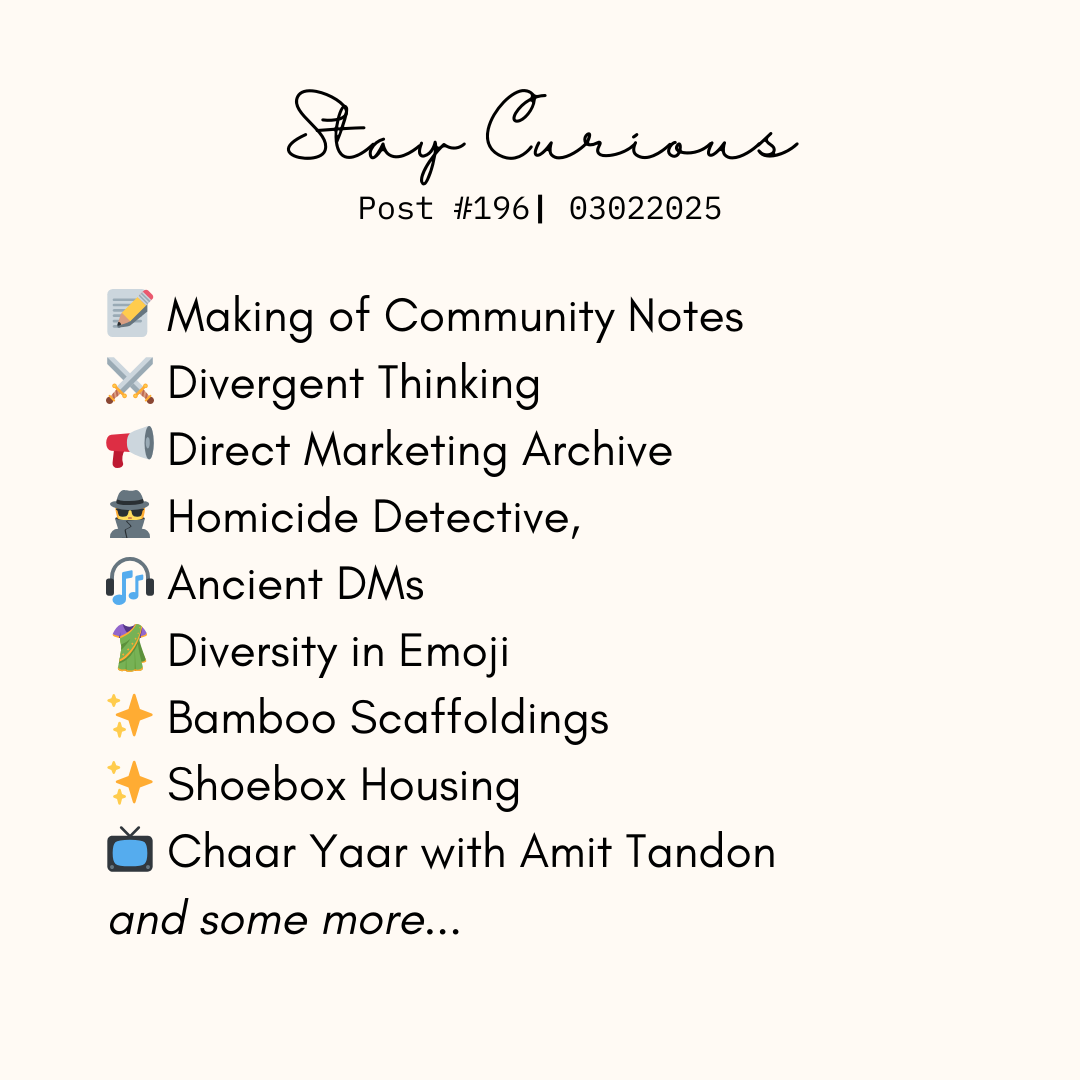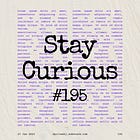📚 Making of community notes, Divergent thinking, Direct marketing archive, Homicide detective, Ancient DMs
Diversity in emojis, Bamboo scaffoldings, Shoebox houses & Chaar yaar
Hello, this is post #196!
Our little one turned six this week! We threw a birthday party for her close friends on Sunday, and the whole week flew by in a blur of planning. I go all in on decorations, while S takes charge of the food. Our mantra? The more, the merrier.
Planning the games is the real adventure. We spend weeks collecting ideas, only to get completely stuck when it’s time to choose. Every time, we debate, rethink, and second-guess. But all that research pays off—we always land on one or two games that turn out to be absolute hits. And in the end, that’s what makes it all worth it!
Growing up, birthdays were simple—celebrated at home with friends, neighbors, and relatives. Decorations were basic, food was predictable (Pav Bhaji, Chole Bhature, or something similar on repeat), and return gifts were small. But the fun? Unmatched. I still have photos from those days, and just looking at them brings back the laughter and chaos.
Now, birthday parties happen in restaurants (even breweries these days) or play zones with ball pits, pretend-play setups, and bowling alleys. It’s a different vibe. Maybe I’m just nostalgic, but those home parties felt more personal. Of course, for kids, it’s all about hanging out with friends, running wild, and grabbing cool return gifts—venue doesn’t matter much to them.
Anyway, it was a packed week, so today’s lineup is a bit lighter. I’ve got two solid podcast recommendations and a deep dive into some brilliant direct marketing campaigns. Plenty to keep you entertained. Here’s what’s on the menu:
Let’s get started…
📝 Making of Community Notes
In the ongoing debate about content moderation and curbing misinformation, Twitter/X’s Community Notes have emerged as an interesting solution.
In “The Making of Community Notes,” the team behind the feature breaks down their design process and the philosophy guiding their approach. Tackling misinformation is a tricky problem—it requires handling a lot of nuance, and their solution is designed to address that complexity.
This discussion offers a great peek into their thought process. Here are a couple of my favorite takeaways from the post:
Keith: The other thing that emerged was that it became clear that notes shouldn't really stand on the author's reputation. The notes should stand on their own. You should be able to read the note, and it should give you the information and cite the sources needed for you to get what you want from it. It was much more powerful to do that than to try to rest it on one individual's identity. It was a surprise to us. In hindsight, it seems kind of obvious that it's better, but it was not our initial instinct.
Emily: I don't think you will ever hear any of us — anybody who worked on this project — ever say the word “fact check.” There's a care to avoid using that phrasing in any of the things we say about the product, any of the language about it, anything on the product surface, because it's entirely about providing context and information and then letting you make your own decision about how to trust it. That's what leads to that higher trust. But, as Lucas said, we're working through a lot of people's priors on what the box on a tweet means. And everybody else still calls it a “fact check.”
(via sidebar.io)
⚔️ Divergent Thinking
Divergent thinking is pure, open-ended idea generation. It involves tossing out ideas as they come to mind while resisting the urge to judge their quality. Brainstorming and freewriting are classic examples of divergent thinking.
Convergent thinking, on the other hand, is analytic and evaluative. It attempts to arrive at the best idea or correct solution. You can think of divergent thinking as ‘expanding outwards’ and convergent thinking as ‘narrowing down’.
“How and When to Think Divergently” is a short but insightful read on balancing divergent and convergent thinking. One common mistake is seeing them as opposing modes when, in reality, most creative projects require a mix of both.
The "go deep, wide, narrow, then up" approach offers a practical way to navigate the creative process. It's not just for design—these lessons apply across many fields. Worth a read!
📢 Direct Marketing Archive
Direct Marketing was THE most unfashionable form of advertising.
‘The shit that folds’ is how Steve Harrison described the popular view at when he joined the business in ’85.
He went on to prove that it didn’t need to fold or be shit.
His DM came in the form of water-coolers, carpet tiles, even a barge on the Thames.
Trojan objects that made their way into places that an envelope could never dream of penetrating.
Some are like Banksy stunts.
Even the stuff that did fold was great. (See the Times Newspaper summons and Court Security pre-opened letter below.)
What they have in common is that they’re impossible to ignore and they persuade you the product is very good.
It sounds so basic, so simple.
This week, I got completely lost in Dave Dye’s “Direct Marketing Archive” — and it was worth it! The collection is insanely good, with every other entry making me go aha!
Here’s a quick sample for you:
Bookmark this one and revisit whenever you have time—pure inspiration and awe!
🎧 Homicide Detective, Ancient DMs
If you’re looking for some great podcast episodes to add to your queue, here are a couple I highly recommend:
What It’s Like To Be: A Homicide Detective: Cracking decades-old murder cases, delivering unthinkable news to victims' families—why are cold cases harder to solve these days? And what's a "415"? Homicide detective John Lamberti from the LAPD shares fascinating insights with Dan Heath in this gripping episode. John is a natural storyteller, making this a super fun listen.
99% invisible: Ancient DMs: Roman Mars chats with Lisa Wilhelmi about 2,500-year-old documents that capture everyday life from back then—the DMs of their time. These ancient messages reveal the joys and worries of daily life, and as always, Roman Mars makes the story even more fun to hear.
🥻 Diversity in Emoji
The world of emojis is fascinating—not in the way the Emoji Movie showed, but because each tiny symbol has a story. There are unspoken rules about how we use them, rules that have nothing to do with grammar or formal language.
The alphabet of emojis forces a language of economy. Emoji characters are not a complete set; they do not represent everything, much less complex concepts, and so the amateur linguist must be creative and strategic to communicate. Depictions of objects take on broader or more interpretive definitions. For this reason, the 🍆 has acquired a meaning that’s, well, sort of 😳.
Juggernaut took a deep dive into why there are 25 clock emojis but no dosas or samosas. Those are just examples, but they highlight a bigger issue—emoji representation is pretty uneven. The reasons go back to the early days of emojis, shaped by history and culture. This post breaks it all down in a way that makes sense.
These Japanese origins explain the disproportionate number of Japan-related graphics in the modern emoji set — carp streamers (🎏), Hinamatsuri dolls (🎎), a Shinto shrine (⛩️), narutomaki fish cakes (🍥). Even emojis that most don’t recognize as Japanese have this origin. The multistory building with a heart and an ‘H’ (🏩) is not a hospital, but rather a Japanese love hotel. And the three monkeys covering their eyes, ears, and mouth (🙈🙉🙊) are based on the famous “Three Wise Monkeys” carvings at the Toshogu shrine. The word “emoji” itself, though its exact origin is unclear, is a portmanteau of the Japanese words for “picture” and “character” — no etymological relation to the English word “emotion.”
Give this one a read to know more of what goes behind the scene. It’s a fascinating world that is shaping a lot of how we express ourselves.
And if you’re game to explore some more about emoji, I’ve covered an eclectic set of finds over the years. Here’s a quick list: changing meaning & role of the Cry-Laughing Face emoji, 99% Invisible on how emojis are designed, emoji kitchen browser game and Alex Komoroske explains coordination headwinds using emojis.
✨ Everything else
Why Hong Kong uses bamboo scaffolding: This visual explainer dives into an ancient engineering technique that continues to thrive in one of the world’s most modern concrete jungles. The South China Morning Post team seems to be good at these visual essays — check out “Life in Hong Kong’s shoebox housing” for another brilliant example of their storytelling!
Chaar Yaar with Amit Tandon is one of my favorite YouTube shows (he calls it a podcast, but I’m still wrapping my head around video podcasts). Amit Tandon has this easygoing vibe that gets his guests to open up, making every conversation feel fun and effortless. The latest episode with Tanmay Bhat, Anu Menon, and Gaurav Kapur was a nostalgia trip straight back to the VJ era and the early days of “experience” music. The behind-the-scenes stories? Absolutely wild. Give it a listen!
ICYMI…
And I know a lot of you did miss this one, here’s a quick link to last week’s post.
That's all for this week, folks!
I hope I've earned the privilege of your time.
If you liked this post, please hit the ❤️ below and leave a comment to tell me more. Forward it to a friend who will find it useful, there is no better way to make this world more curious!







Have bookmarked divergent thinking and the article about homicide detective for later reading. Am sure there are many stories, serials and movies etc around homicide detectives but the one I kind of enjoyed quite a bit is Brooklyn 99. It may not be anywhere close to real life but I like the somewhat lightheartedness 😁